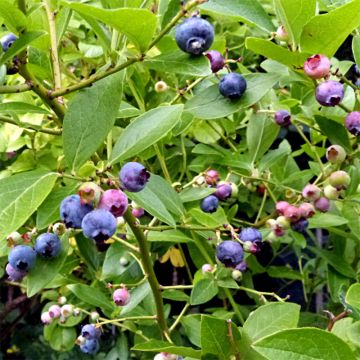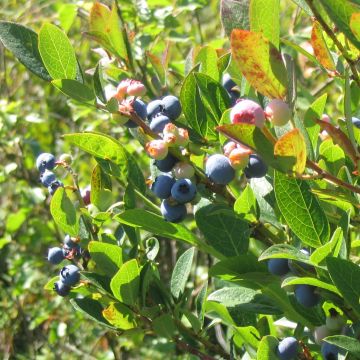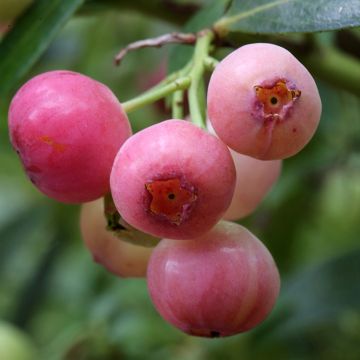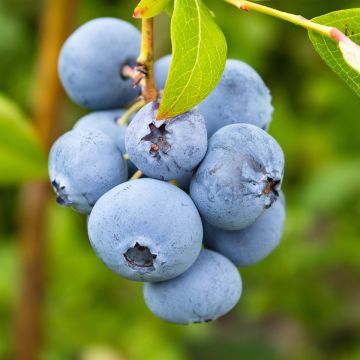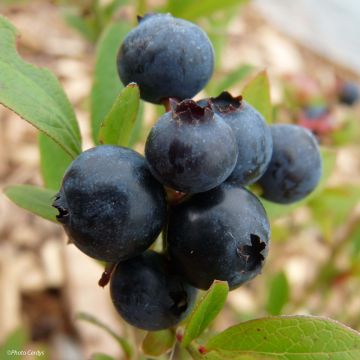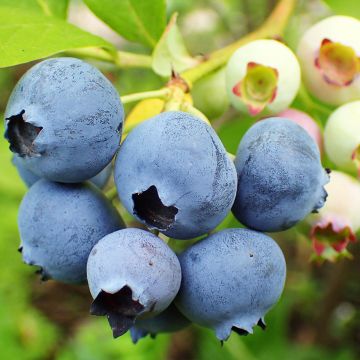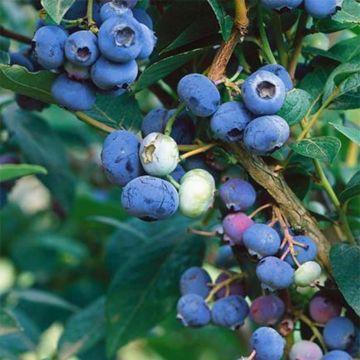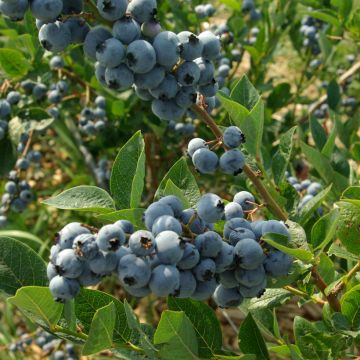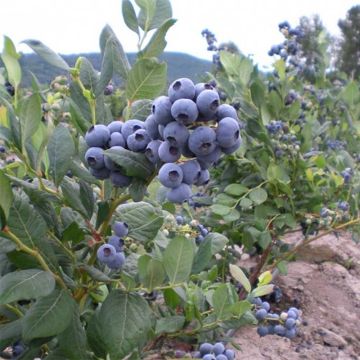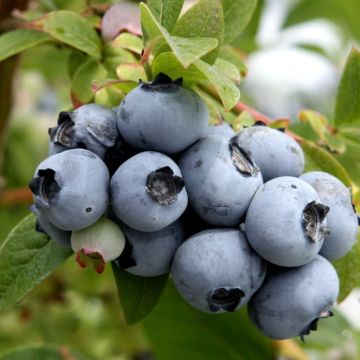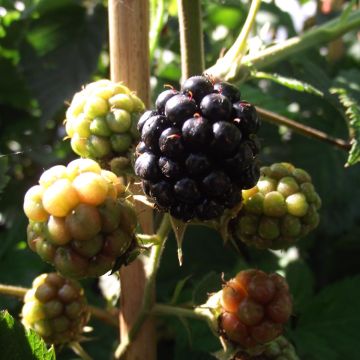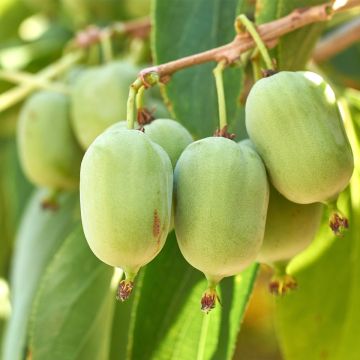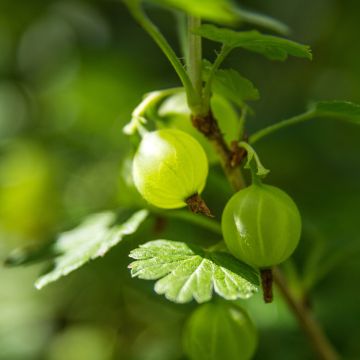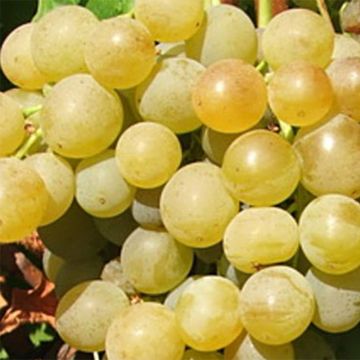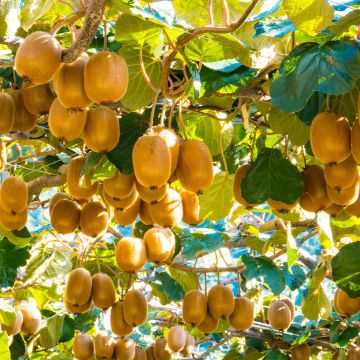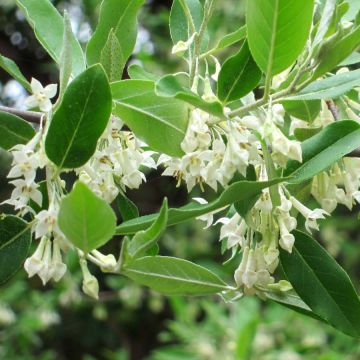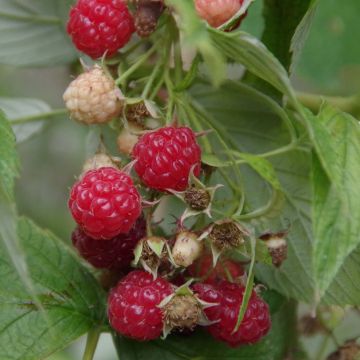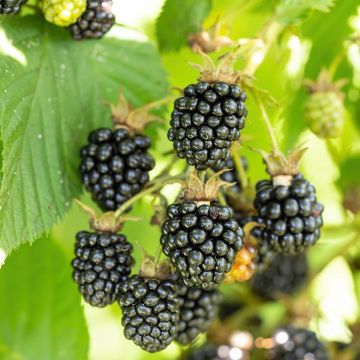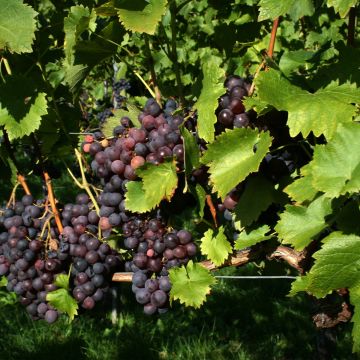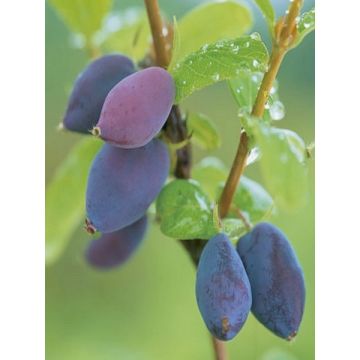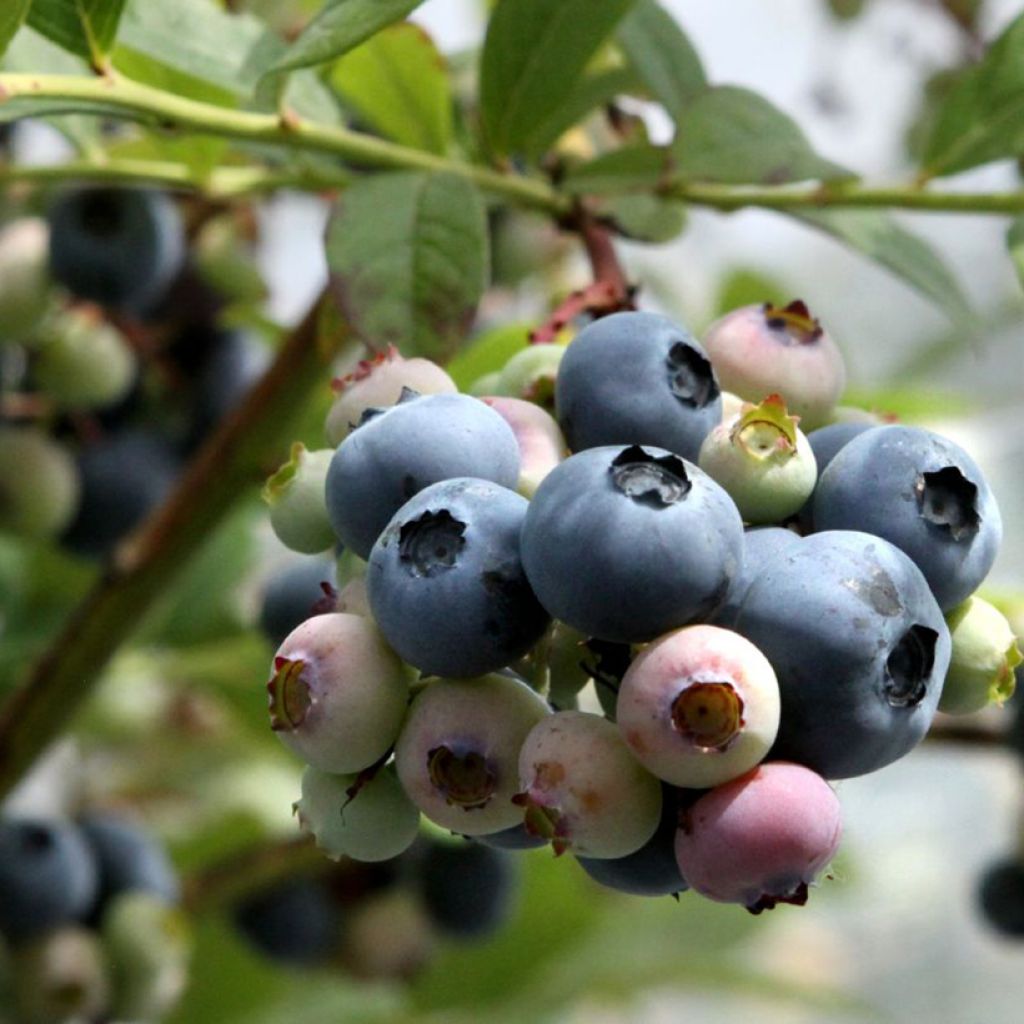

Vaccinium corymbosum Blue Dessert
Vaccinium corymbosum Blue Dessert
Vaccinium corymbosum Blue Dessert ®
American Blueberry, Highbush Blueberry
This item cannot be shipped to the selected country
Delivery charge from €5.90
More information
Schedule delivery date,
and select date in basket
This plant carries a 6 months recovery warranty
More information
We guarantee the quality of our plants for a full growing cycle, and will replace at our expense any plant that fails to recover under normal climatic and planting conditions.
From €5.90 for pickup delivery and €6.90 for home delivery
Express home delivery from €8.90.
Description
The 'Blue Dessert' Blueberry is a late-flowering and fruiting variety of American blueberry. It blooms in June and the fruit harvest begins in late August to early September and can sometimes last until October depending on the climatic conditions. The late ripening has the advantage of allowing for a long harvesting period. Its fruits are medium to large-sized, sweet and juicy, slightly aromatic. Its late flowering allows it to avoid exposure to spring frosts. It has an upright habit, robust growth, and forms a well-branched bush. The cultivated blueberry is a bush that requires acidic and moist soil, free of limestone. This variety tolerates non-burning sunlight exposure for better fruit production. It is also appreciated for its beautiful red autumn colouration before the deciduous foliage falls.
The Blueberry belongs to the Ericaceae family, mainly known in gardens for its many ornamental genera. In addition to the well-known Rhododendrons and Heather, there are also Ericaceae with edible fruits: mainly the Strawberry Trees and the genus Vaccinium, which includes blueberries, cranberries, and lingonberries. The cultivated blueberry (Vaccinium corymbosum), native to North America, is the one that is grown in gardens for its abundant and high-quality fruit production. It is a very cold-resistant bush with deciduous foliage that falls in autumn. It is cultivated in very acidic soil (free of limestone), with a tendency towards peat and humus, with a semi-shaded exposure, for example, in morning sunlight.
'Blue Dessert' is an upright variety that reaches a height of 1.50 m (5ft), and a width of 80 cm (32in) to 1 m (3ft). It is adorned with numerous small white flowers in June, with the characteristic bell-like appearance of the Ericaceae due to their fused petals. They then develop into blue berries, ready to be harvested from late August, and are excellent for their slightly acidic sweet taste and juicy flesh. Blueberries are low in calories but high in nutritional value: they are rich in vitamins A, B, and C, calcium, and iron. They can be eaten freshly picked, enjoyed in juice, jam, jelly, sorbet, or in baking (pies, muffins). Blueberries can be stored for about ten days after picking and can be frozen for longer preservation. Since 'Blue Dessert' is self-fertile, you will not need to plant another variety to obtain a tasty harvest. However, in blueberries, cross-pollination has a significant impact on yield and fruit quality, so planting a second plant is beneficial. The medium to dark green foliage consists of small elliptical leaves with pointed tips, which turn red in autumn, adding considerable ornamental appeal.
The 'Blue Dessert' blueberry will delight fans of small fruits. Both a fruit-bearing and ornamental plant due to its flowering and beautiful autumn colours, this shrub can be grown on a balcony or terrace to enjoy its fruits within easy reach, or be combined with other acid-loving plants in a heather bed in the garden. The border can then be made up of creepers, such as Andromeda polifolia 'Blue Ice', a dwarf shrub with fine bluish foliage and bell-shaped pink flowers in spring. The Clethra alnifolia 'Ruby Spice' will also be a good companion, with its fragrant pink late-summer flowering and the yellow autumn colours of its foliage, creating a beautiful scene alongside the red of your blueberry.
Report an error about the product description
Vaccinium corymbosum Blue Dessert in pictures
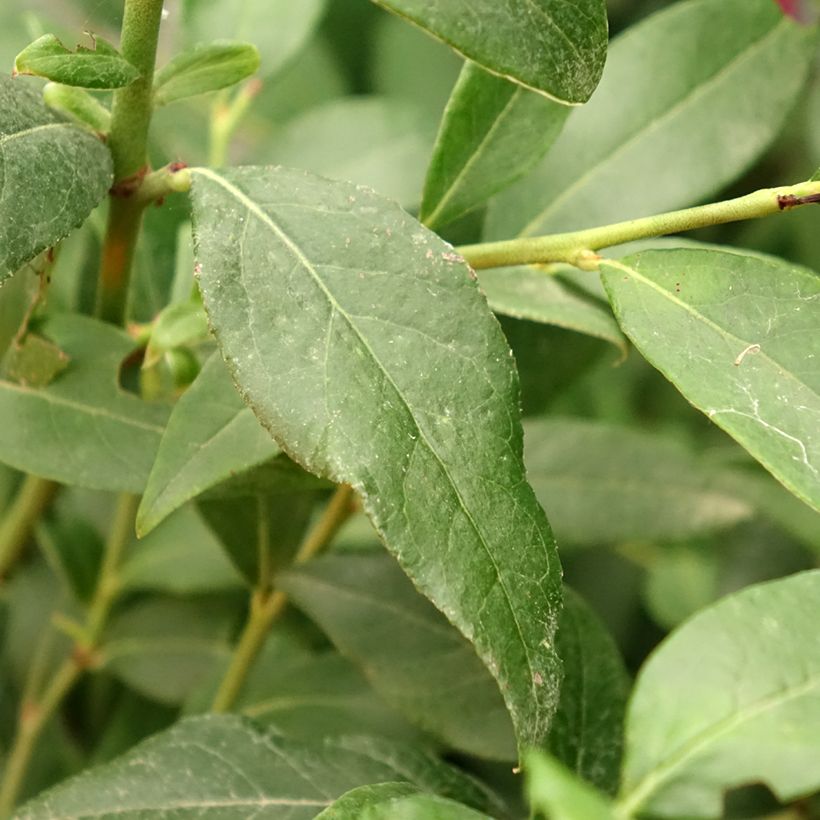

Plant habit
Fruit
Flowering
Foliage
Botanical data
Vaccinium
corymbosum
Blue Dessert ®
Ericaceae
American Blueberry, Highbush Blueberry
Cultivar or hybrid
Other Blueberry bush
Planting and care
The planting of the blueberry bush is ideally done in autumn or throughout the year, except during freezing temperatures. This bush should be planted in full sun in the north of Europe and preferably in partial shade in the south. If you plant multiple plants, space them 1.20m (4ft) apart in all directions. The blueberry bush 'Blue Dessert' is quite hardy (up to -20°C for the plant but -5°C for the flowers) and it appreciates a sunny exposure for its fruit production.
Plant it in an acidic soil (pH between 4 and 5.5), incorporating pure ericaceous soil or a mixture of ordinary soil and well-decomposed pine bark compost. The collar should be level with the ground. Firmly pack the soil and water generously. In slightly chalky soil, dig a hole 50 to 60cm (20 to 24in) deep, line the edges with a garden felt, lay a non-chalky gravel bed 10cm (4in) thick at the bottom, then fill with a mixture of ericaceous soil.
The soil should remain moist but not waterlogged: the plant tolerates moderate drought and dislikes stagnant moisture. If watering is necessary, use non-chalky and non-chlorinated water (e.g. rainwater). Lime inevitably causes the yellowing of the leaves around the veins, which remain green. Eventually, the bush will decline. Mulch the base with shredded bark, straw, or fern leaves. Sometimes it is useful to place a protective net if birds become too greedy during harvest. In spring, annually apply a bit of well-rotted compost on the surface. The Bblueberry bush is not very susceptible to diseases and pests.
Planting period
Intended location
Care
This item has not been reviewed yet - be the first to leave a review about it.
Berries
Haven't found what you were looking for?
Hardiness is the lowest winter temperature a plant can endure without suffering serious damage or even dying. However, hardiness is affected by location (a sheltered area, such as a patio), protection (winter cover) and soil type (hardiness is improved by well-drained soil).

Photo Sharing Terms & Conditions
In order to encourage gardeners to interact and share their experiences, Promesse de fleurs offers various media enabling content to be uploaded onto its Site - in particular via the ‘Photo sharing’ module.
The User agrees to refrain from:
- Posting any content that is illegal, prejudicial, insulting, racist, inciteful to hatred, revisionist, contrary to public decency, that infringes on privacy or on the privacy rights of third parties, in particular the publicity rights of persons and goods, intellectual property rights, or the right to privacy.
- Submitting content on behalf of a third party;
- Impersonate the identity of a third party and/or publish any personal information about a third party;
In general, the User undertakes to refrain from any unethical behaviour.
All Content (in particular text, comments, files, images, photos, videos, creative works, etc.), which may be subject to property or intellectual property rights, image or other private rights, shall remain the property of the User, subject to the limited rights granted by the terms of the licence granted by Promesse de fleurs as stated below. Users are at liberty to publish or not to publish such Content on the Site, notably via the ‘Photo Sharing’ facility, and accept that this Content shall be made public and freely accessible, notably on the Internet.
Users further acknowledge, undertake to have ,and guarantee that they hold all necessary rights and permissions to publish such material on the Site, in particular with regard to the legislation in force pertaining to any privacy, property, intellectual property, image, or contractual rights, or rights of any other nature. By publishing such Content on the Site, Users acknowledge accepting full liability as publishers of the Content within the meaning of the law, and grant Promesse de fleurs, free of charge, an inclusive, worldwide licence for the said Content for the entire duration of its publication, including all reproduction, representation, up/downloading, displaying, performing, transmission, and storage rights.
Users also grant permission for their name to be linked to the Content and accept that this link may not always be made available.
By engaging in posting material, Users consent to their Content becoming automatically accessible on the Internet, in particular on other sites and/or blogs and/or web pages of the Promesse de fleurs site, including in particular social pages and the Promesse de fleurs catalogue.
Users may secure the removal of entrusted content free of charge by issuing a simple request via our contact form.
The flowering period indicated on our website applies to countries and regions located in USDA zone 8 (France, the United Kingdom, Ireland, the Netherlands, etc.)
It will vary according to where you live:
- In zones 9 to 10 (Italy, Spain, Greece, etc.), flowering will occur about 2 to 4 weeks earlier.
- In zones 6 to 7 (Germany, Poland, Slovenia, and lower mountainous regions), flowering will be delayed by 2 to 3 weeks.
- In zone 5 (Central Europe, Scandinavia), blooming will be delayed by 3 to 5 weeks.
In temperate climates, pruning of spring-flowering shrubs (forsythia, spireas, etc.) should be done just after flowering.
Pruning of summer-flowering shrubs (Indian Lilac, Perovskia, etc.) can be done in winter or spring.
In cold regions as well as with frost-sensitive plants, avoid pruning too early when severe frosts may still occur.
The planting period indicated on our website applies to countries and regions located in USDA zone 8 (France, United Kingdom, Ireland, Netherlands).
It will vary according to where you live:
- In Mediterranean zones (Marseille, Madrid, Milan, etc.), autumn and winter are the best planting periods.
- In continental zones (Strasbourg, Munich, Vienna, etc.), delay planting by 2 to 3 weeks in spring and bring it forward by 2 to 4 weeks in autumn.
- In mountainous regions (the Alps, Pyrenees, Carpathians, etc.), it is best to plant in late spring (May-June) or late summer (August-September).
The harvesting period indicated on our website applies to countries and regions in USDA zone 8 (France, England, Ireland, the Netherlands).
In colder areas (Scandinavia, Poland, Austria...) fruit and vegetable harvests are likely to be delayed by 3-4 weeks.
In warmer areas (Italy, Spain, Greece, etc.), harvesting will probably take place earlier, depending on weather conditions.
The sowing periods indicated on our website apply to countries and regions within USDA Zone 8 (France, UK, Ireland, Netherlands).
In colder areas (Scandinavia, Poland, Austria...), delay any outdoor sowing by 3-4 weeks, or sow under glass.
In warmer climes (Italy, Spain, Greece, etc.), bring outdoor sowing forward by a few weeks.

































